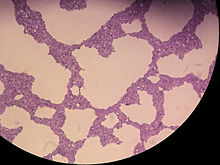Rhodotorula
| Rhodotorula | |
|---|---|

| |
| Rhodotorula mucilaginosa colonies on Sabouraud agar (with 2 % glucose) | |
| Scientific classification | |
| Domain: | Eukaryota |
| Kingdom: | Fungi |
| Division: | Basidiomycota |
| Class: | Microbotryomycetes |
| Order: | Sporidiobolales |
| Family: | Sporidiobolaceae
|
| Genus: | Rhodotorula F.C. Harrison (1927) |
| Type species | |
Fresen. ) F.C. Harrison (1928)
| |
| Synonyms | |
|
Chromotorula F.C. Harrison (1927) | |

Rhodotorula is a
Taxonomy
Rhodotorula was created in 1927 by Canadian
In 1967 Japanese mycologist Isao Banno introduced the genus Rhodosporidium for the sexual state of Rhodotorula, producing
Habitat
Rhodotorula species are common environmental inhabitants. They can be cultured from soil, water, milk, fruit juice, and air samples.[4] They are able to scavenge nitrogenous compounds from their environment remarkably well, growing even in air that has been carefully cleaned of any fixed nitrogen contaminants. In such conditions, the nitrogen content of the dry weight of the Rhodotorula species can drop as low as 1%, compared to around 14% for most bacteria growing in normal conditions.[5]
Pathology
Only Rhodotorula mucilaginosa and R. glutinis have been known to cause disease in humans. There were no reported cases of Rhodotorula infections before 1985.[4] There were however forty-three reported cases of Rhodotorula bloodstream infections (BSIs) between 1960 and 2000.[6] Rhodotorula species are most commonly found in patients who are immunosuppressed and/or are using foreign-body technology such as central venous catheters.[6] Rhodotorula infection is commonly treated by removing the catheter and the use of anti-fungals. Rhodotorula species are susceptible to amphotericin B and flucytosine.[6]
Rhodotorula species can also cause infections in animals. There have been reports of skin infections in chickens and sea animals and lung infections and otitis in sheep and cattle.[4]
Potential in bioremediation
One area in which Rhodotorula species may become of importance is in
Species
- Rhodotorula alborubescens
- Rhodotorula araucariae
- Rhodotorula babjevae
- Rhodotorula dairenensis
- Rhodotorula diobovata
- Rhodotorula evergladiensis
- Rhodotorula glutinis
- Rhodotorula graminis
- Rhodotorula incarnata
- Rhodotorula kratochvilovae
- Rhodotorula mackellariae
- Rhodotorula mucilaginosa
- Rhodotorula ngohengohe
- Rhodotorula pacifica
- Rhodotorula paludigena
- Rhodotorula sampaioana
- Rhodotorula sphaerocarpa
- Rhodotorula taiwanensis
- Rhodotorula toruloides
- Rhodotorula tokyoensis
- Rhodotorula yunnanensis
References
- ^ PMID 26951631.
- PMID 32206137.
- ^ Banno I (1967). "Studies on the sexuality of Rhodotorula". J. Gen. Appl. Microbiol. 13: 167–196.
- ^ PMID 23091485.
- ^ Postgate, John: "The Outer Reaches of Life", page 132-134. Cambridge University Press, 1994
- ^ PMID 14605170.
- PMID 25886005.
- PMID 11556149.
- PMID 8517753.
- S2CID 8263841.
- PMID 29375494.
